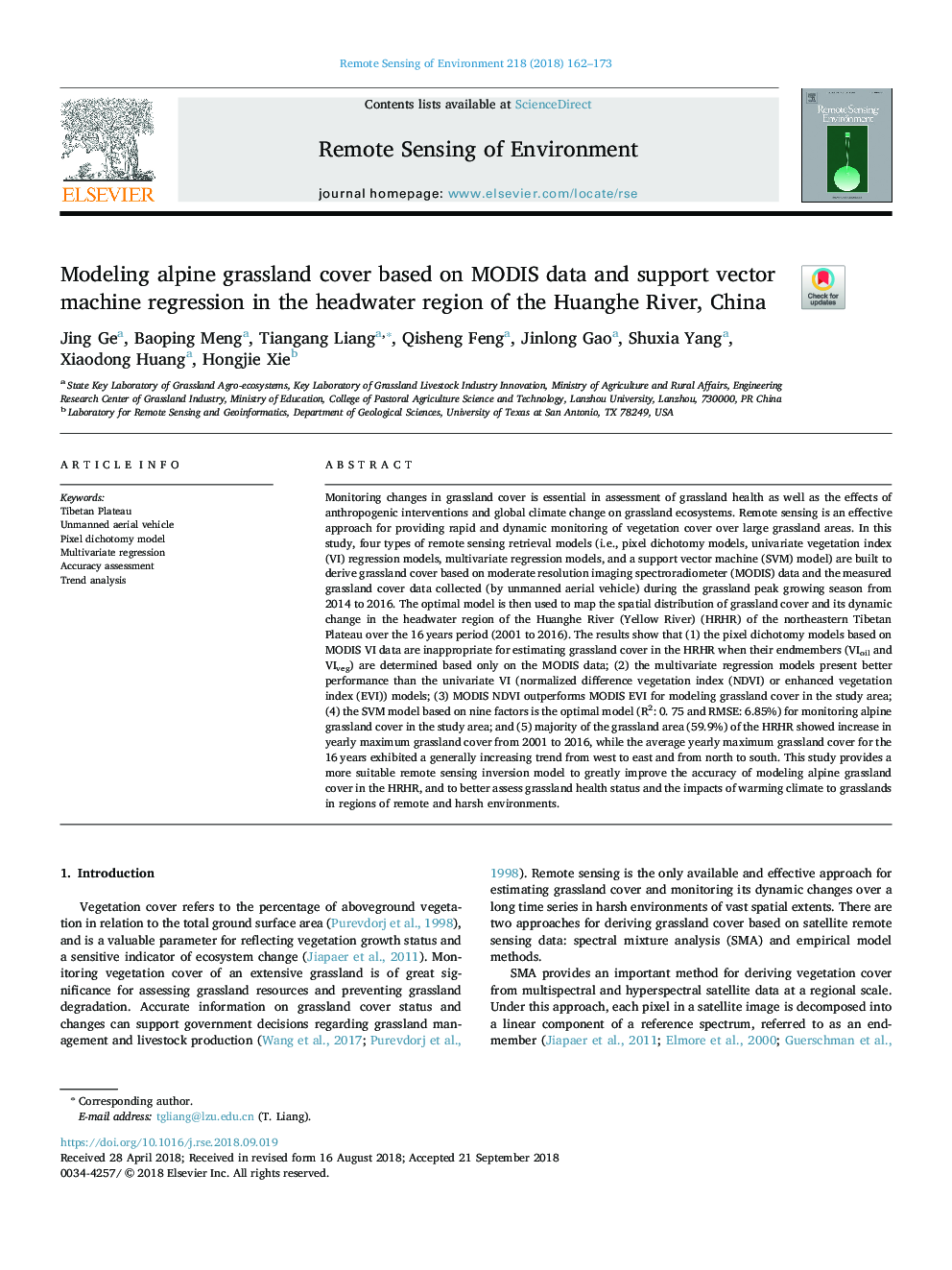| کد مقاله | کد نشریه | سال انتشار | مقاله انگلیسی | نسخه تمام متن |
|---|---|---|---|---|
| 11025038 | 1701037 | 2018 | 12 صفحه PDF | دانلود رایگان |
عنوان انگلیسی مقاله ISI
Modeling alpine grassland cover based on MODIS data and support vector machine regression in the headwater region of the Huanghe River, China
دانلود مقاله + سفارش ترجمه
دانلود مقاله ISI انگلیسی
رایگان برای ایرانیان
کلمات کلیدی
موضوعات مرتبط
مهندسی و علوم پایه
علوم زمین و سیارات
کامپیوتر در علوم زمین
پیش نمایش صفحه اول مقاله

چکیده انگلیسی
Monitoring changes in grassland cover is essential in assessment of grassland health as well as the effects of anthropogenic interventions and global climate change on grassland ecosystems. Remote sensing is an effective approach for providing rapid and dynamic monitoring of vegetation cover over large grassland areas. In this study, four types of remote sensing retrieval models (i.e., pixel dichotomy models, univariate vegetation index (VI) regression models, multivariate regression models, and a support vector machine (SVM) model) are built to derive grassland cover based on moderate resolution imaging spectroradiometer (MODIS) data and the measured grassland cover data collected by unmanned aerial vehicle during the grassland peak growing season from 2014 to 2016. The optimal model is then used to map the spatial distribution of grassland cover and its dynamic change in the headwater region of the Huanghe River (Yellow River) (HRHR) of the northeastern Tibetan Plateau over the 16â¯years period (2001 to 2016). The results show that (1) the pixel dichotomy models based on MODIS VI data are inappropriate for estimating grassland cover in the HRHR when their endmembers (VIsoil and VIveg) are determined based only on the MODIS data; (2) the multivariate regression models present better performance than the univariate VI (normalized difference vegetation index (NDVI) or enhanced vegetation index (EVI)) models; (3) MODIS NDVI outperforms MODIS EVI for modeling grassland cover in the study area; (4) the SVM model based on nine factors is the optimal model (R2: 0. 75 and RMSE: 6.85%) for monitoring alpine grassland cover in the study area; and (5) majority of the grassland area (59.9%) of the HRHR showed increase in yearly maximum grassland cover from 2001 to 2016, while the average yearly maximum grassland cover for the 16â¯years exhibited a generally increasing trend from west to east and from north to south. This study provides a more suitable remote sensing inversion model to greatly improve the accuracy of modeling alpine grassland cover in the HRHR, and to better assess grassland health status and the impacts of warming climate to grasslands in regions of remote and harsh environments.
ناشر
Database: Elsevier - ScienceDirect (ساینس دایرکت)
Journal: Remote Sensing of Environment - Volume 218, 1 December 2018, Pages 162-173
Journal: Remote Sensing of Environment - Volume 218, 1 December 2018, Pages 162-173
نویسندگان
Jing Ge, Baoping Meng, Tiangang Liang, Qisheng Feng, Jinlong Gao, Shuxia Yang, Xiaodong Huang, Hongjie Xie,